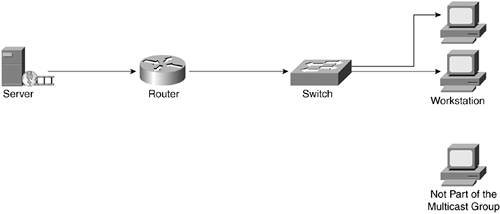Transmission Methods
LAN data transmissions at Layer 2 fall into three classifications: unicast, multicast, and broadcast. In each type of transmission, a single frame is sent to one node on the network. If the frame is to be sent to more than one node on the network, the sender must send individual unicast data streams to each node.
In a unicast transmission, a single frame or packet is sent from a single source to a single destination on a network. In a multicast transmission environment, a single data frame or a single source to multiple destinations packet is copied and sent to a specific subset of nodes on the network. In a broadcast transmission environment from a single source to all nodes, a single data frame or packet is copied and sent to all nodes on the network.
Unicast
Unicast is a one-to-one transmission method in which the network carries a message to one receiver, such as from a server to a LAN workstation. In a unicast environment, even though multiple users might ask for the same information from the same server at the same time, such as a video clip, duplicate data streams are sent. One stream is sent to each user, as illustrated in the Figure 6-3.
Figure 6-3. Unicast Operation

Unicast sends separate data streams to each computer requesting the data, in turn flooding the network with traffic. Unicast might be compared to an after-work gathering. You and several of your co-workers might be going to the same destination, but each taking his own vehicle, flooding the streets with cars. (So the next time you go to an after-work gathering, and each person drives his own car, tell them you're "unicasting.")
Multicast
Multicast is a one-to-many transmission method in which the network carries a message to multiple receivers at the same time. Multicast is similar to broadcasting, except that multicasting means sending to a specific group, whereas broadcasting implies sending to everybody, whether they want the traffic or not. When sending large amounts of data, multicast saves considerable network bandwidth because the bulk of the data is sent only once. The data travels from its source through major backbones and is then multiplied, or distributed out, at switching points closer to the end users (see Figure 6-4) . This is more efficient than a unicast system, in which the data is copied and forwarded to each recipient.
Figure 6-4. Multicast Operation

Multicast conserves network bandwidth by sending a single data stream across the network, much as you and others might carpool to and from work, thereby reducing the traffic on the roads. For example, a few of you might ride together to some point, such as a drop-off point in the city, and then disperse from there. Multicasting works in the same way by using the concept of shared transmission across a network. Multicasting sends the data to a predetermined endpoint, such as a switch, where the traffic is sent to each intended recipient, instead of each traffic stream being sent from start to finish across the network, independent of others.
Broadcast
Broadcast is a one-to-all transmission method in which the network carries a message to all devices at the same time, as illustrated in Figure 6-5.
Figure 6-5. Broadcast Operation

Broadcast message traffic is sent out to every node on the network where the broadcast is not filtered or blocked by a router. Broadcasts are issued by the Address Resolution Protocol (ARP) for address resolution when the location of a user or server is not known. For example, the location could be unknown when a network client or server first joins the network and identifies itself. Sometimes broadcasts are a result of network devices continually announcing their presence in the network, so that other devices don't forget who is still a part of the network. Regardless of the reason for a broadcast, the broadcast must reach all possible stations that might potentially respond.






